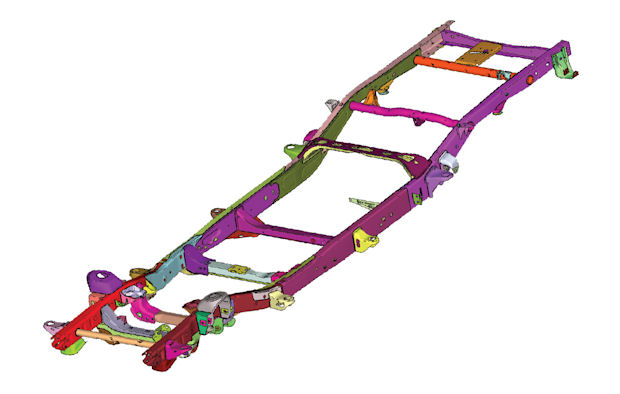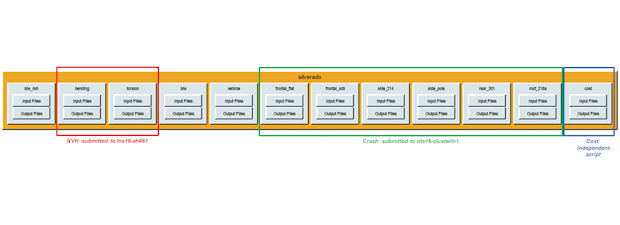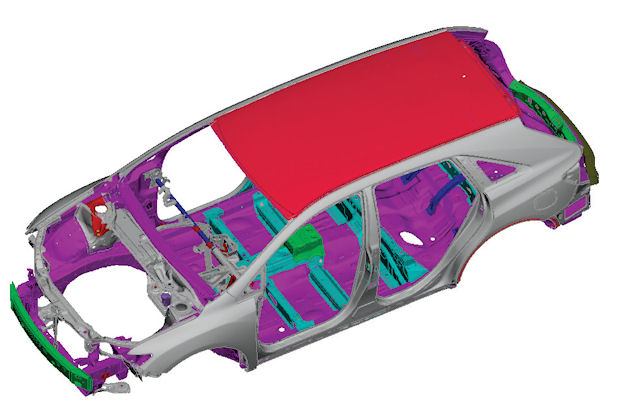Man Meets Software: The Culmination of Collaborative Optimization

Using HEEDS, the EDAG team was able to determine that a multi-material design for the frame was the optimal lightweighting strategy for a pick-up truck. Images courtesy of EDAG.
Design Exploration and Optimization News
Design Exploration and Optimization Resources


Latest News
February 1, 2015
 Using HEEDS, the EDAG team was able to determine that a multi-material design for the frame was the optimal lightweighting strategy for a pick-up truck. Images courtesy of EDAG.
Using HEEDS, the EDAG team was able to determine that a multi-material design for the frame was the optimal lightweighting strategy for a pick-up truck. Images courtesy of EDAG.Lightweighting a production vehicle design is a laborious process demanding all hands on deck. So when the Environmental Protection Agency (EPA) called on EDAG to help vet the impact of more rigorous Corporate Average Fuel Economy (CAFE) standards, the engineering services firm teamed up its best experts with collaborative optimization software technology to get the job done.
With so many variables to consider and with deadline pressures looming, manual design studies were out. Traditional optimization software could lend a hand automating the exploration process, but there were limits to what could be accomplished without human intervention.
EDAG found middle ground in the form of Red Cedar Technology Inc.’s HEEDS multi-disciplinary cooperative optimization software, a platform that lets engineers’ know-how guide the optimization process to come up with the best possible designs in the most expedient fashion.
“When we just have the computer do the optimization analysis, it could take three to four weeks to get the results and after all that, it may not be right or might not satisfy everyone on the team,” says Javier Rodriguez, EDAG’s director of vehicle integration. “HEEDS allows us to get human intelligence into the [optimization] analysis while it’s running. That way, we can make modifications based on engineers’ input and keep things going. It’s a very collaborative resource.”
A Lightweighting Framework
Before the government pulls the trigger on more aggressive fuel economy standards—including the 2012 mandate to raise the average fuel efficiency of new cars and trucks to 54.4 miles per gallon by 2025—a team of engineering services companies such as EDAG are selected to ensure the proposed levels are reasonable, both from a design and cost stand point. “They want to make sure they are not too onerous and can be accomplished,” Rodriguez says. “They contract us to do engineering studies and get feedback from OEMs (original equipment manufacturers) before they issue the new directives.”
 The HEEDS multi-disciplinary cooperative optimization software lets engineers’ knowledge and experience guide the optimization process to come up with the best possible designs quickly.
The HEEDS multi-disciplinary cooperative optimization software lets engineers’ knowledge and experience guide the optimization process to come up with the best possible designs quickly.This particular weight feasibility reduction study involved the Toyota Venza, a mid-sized cross-over utility vehicle (CUV), and a pick-up truck. There were a range of parameters governing the lightweighting exercise, including that only technologies and techniques that were currently feasible for manufacturability could be considered, and the options had to be cost effective for model year 2017 and model year 2020 high-volume production vehicles. Moreover, the existing vehicle noise, vibration and harshness (NVH) modal characteristics and crash performance had to be maintained as did the overall vehicle safety performance. Compounding the challenge: The total cost impact of the lightweighting changes had to be minimal, not exceeding increases of more than 10%.
Requirements became even more complex considering the scope of what could be lightweighted. In addition to the body-in-white (BIW), a prime system that typically comprises 20% to 25% of the total vehicle curb weight, the body-on-frame was fair game in the pickup truck as was closures, bumpers, doors, fenders, the hood and the tailgate of both vehicle types.
“The question the government or EPA is asking is relatively simple, but you need to deal with a lot of variables,” Rodriguez says. “There’s the potential to change 250 parts in a body structure of a car—each part’s thickness can be changed or its material composition altered. Every change effects weight and performance.”
 EDAG was able to achieve a 14% weight reduction on the body-in-white for the Venza CUV, amounting to a cost impact of $3.06 per kilogram.
EDAG was able to achieve a 14% weight reduction on the body-in-white for the Venza CUV, amounting to a cost impact of $3.06 per kilogram.With so many variables and possible answers, the end result isn’t one answer, but several scenarios that optimally solve the problem—from changing the grade of material to something like high-strength steel or doing a wholesale switch to an alternative like composites or aluminum. Other target areas included geometry changes, spot welds and alternative manufacturing technologies. “There is not one possible solution, but different solutions with different costs,” he says. “Some could give us a 5% weight reduction with a 5% cost increase while others could provide a 10% weight reduction with a 20% cost increase. We needed help analyzing the possible solutions and design concepts quickly.”
A Human Touch
Help came in the form of HEEDS, which factors human expertise and participation into the optimization process unlike some competitive tools, which rely solely on their own algorithms and search routines to analyze results. “The clear difference between HEEDS and other tools is that while it’s running, we encourage users to actually watch the results versus waiting and letting it run in batch mode,” says Angelo Flemings, vice president, Worldwide Business Development at Red Cedar. “Humans have insight and intuition, and no computer software has that.”
Human interaction is particularly important when large and complex models are involved, as in the case with lightweighting design work, Flemings says. “Since these are very large models, you don’t want them to just run and run and run because you might not come up with any feasible designs,” he says. “A human can apply their knowledge or inject input from other successful designs or projects into the optimization. Collaborative engineering in this fashion ends up having real benefits by shortening the amount of time it takes to come up with good solutions.”
In addition to the collaborative aspect, HEEDS facilitates the optimization process in several ways. It provides process automation capabilities to link tools together to come up with optimal designs; it assigns the various software tools the appropriate computing resources; and it has a robust search strategy for efficient design exploration, Flemings explains.
Consider the 2011 Venza lightweighting study using HEEDS to drive a variety of CAE and analysis tools, including Nastran, LS-DYNA for crash tests, Excel costing models and several CAD tools to consider upwards of 484 variables. With some traditional optimization software, the team would have had at least 10 full vehicle models and nearly 5,000 evaluations to consider, Flemings says. With HEEDS’ collaborative optimization approach, the team was able to narrow that down to about 250 evaluations, which in the end, produced 49 feasible designs.
Optimization for All
On the lightweight truck project, the initial thinking was that high-strength steel was the way to achieve the best lightweighting results, but after a week’s worth of analysis, it became clear that aluminum or composites might be a good option. “We ended up with a mix of materials, and the fact that HEEDS allowed us to make that shift was very important,” Rodriguez explains. “In a different [optimization] product, we’d have to stop the analysis and start everything from the beginning.”
Ease of use was another key differentiator of HEEDS compared with other multidisciplinary optimization platforms. HEEDS was easier to set up than other programs, both in its ability to interface with the core CAE tools and in how to refine and drive the actual optimization studies, Rodriguez says. While the typical users of the software were CAE engineers, they were not PhDs in optimization techniques or in optimization software.
“There were people with quite a lot of years of experience, but they were not specifically trained for simulation and optimization,” Rodriguez says of the lightweight truck project team. “Once we established the processes, we could make them available for everyone and it was a very collaborative environment.”
Thanks to the collaborative HEEDS optimization effort, the EDAG team was able to come up with a range of designs that achieved significant weight savings goals yet remained within the cost targets. For the Venza compact SUV, EDAG was able to achieve a 14% weight reduction on the body in white (for a total of 18% to 20% when factoring in the doors and hood) with a cost impact of $3.06 per kilogram. On the pick-up truck, the efforts yielded a 29% weight reduction with a cost impact of $4.71 a kilogram.
Not only did the collaborative optimization approach help yield a broader number of optimized designs faster, it also has been a critical tool for evaluating various scenarios and keeping constituents on the same page.
“HEEDS helps us come to consensus,” Rodriguez says. “There isn’t one optimized, perfect solution, there are several. HEEDS gives us a range of solutions, allows us to look at them, and have everyone work together to choose the one that is best.”
More Info
Subscribe to our FREE magazine, FREE email newsletters or both!
Latest News
About the Author
Beth Stackpole is a contributing editor to Digital Engineering. Send e-mail about this article to [email protected].
Follow DE



